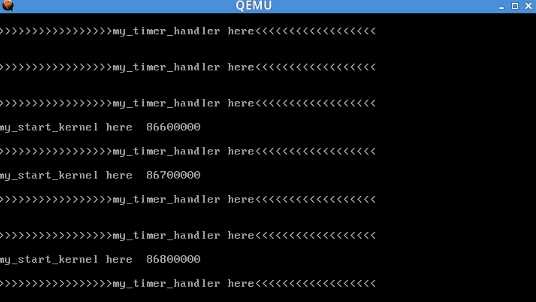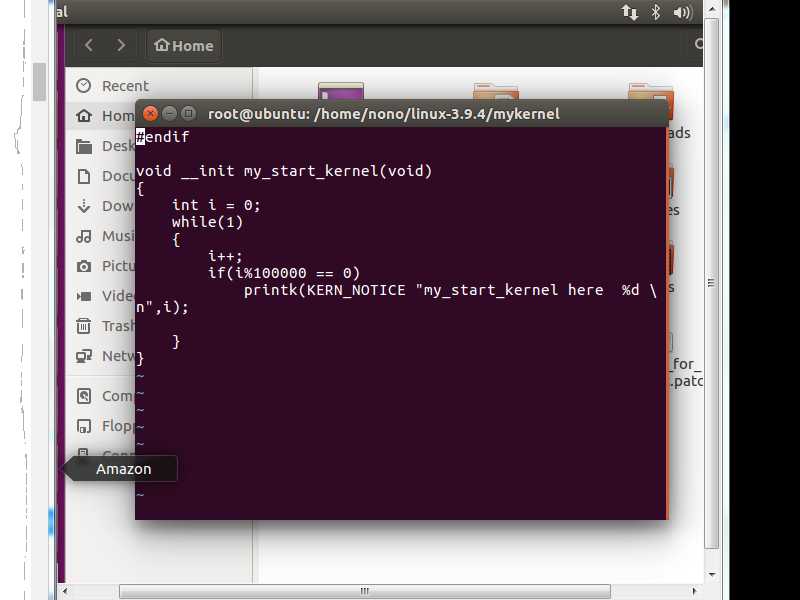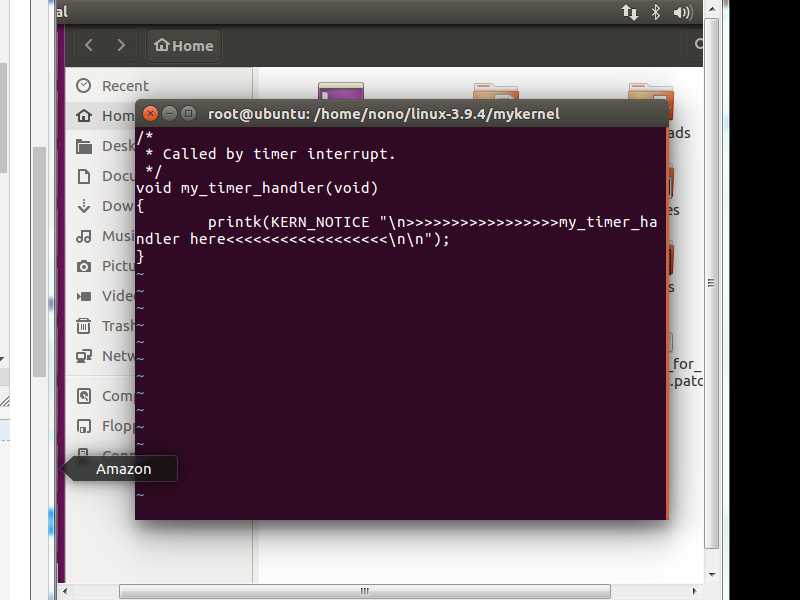标签:sig notice tar inpu RoCE sizeof ice more tpc
学号<202>
原创作品转载请注明出处https://github.com/mengning/linuxkernel/
sudo apt-get install qemu # install QEMU
sudo ln -s /usr/bin/qemu-system-i386 /usr/bin/qemu wget --no-check-certificate https://www.kernel.org/pub/linux/kernel/v3.x/linux- 3.9.4.tar.xz # download Linux Kernel 3.9.4 source code wget --no-check-certificate https://raw.github.com/mengning/mykernel/master/mykernel_for_linux3.9.4sc.patch # download mykernel_for_linux3.9.4sc.patch xz -d linux-3.9.4.tar.xz tar -xvf linux-3.9.4.tar cd linux-3.9.4 patch -p1 < ../mykernel_for_linux3.9.4sc.patch make allnoconfig
make
其中wget指令后要加--no-check-contificate 否则认证无法通过
指令qemu -kernel arch/x86/boot/bzImage可以看到如图成果

打开mymain.c文件如图

打开myinterrupt.c文件,如图

会在start_kernel中运行,定长时间跳到Interrupt中去执行一次
二、一个简单的时间片轮转多道程序
obj-y = mymain.o myinterrupt.o
mymain.o:
cc -c mymain.c mypcb.h
myinterrupt.o:
cc -c myinterrupt.c mypcb.h
修改Makefile ,通过git-clone获取mymain.c 和 interrupt.c
程序运行如图

下面开始分析程序
struct Thread { unsigned long ip; unsigned long sp; }; typedef struct PCB{ int pid; volatile long state; /* -1 unrunnable, 0 runnable, >0 stopped */ char stack[KERNEL_STACK_SIZE]; /* CPU-specific state of this task */ struct Thread thread; unsigned long task_entry; struct PCB *next; }tPCB;
定义了进程和线程的结构体。
pid表示进程编号
state表示进程的状态
stack表示进程的栈
thread表示进程的ip sp的值
task_entry表示进程的入口,第一次执行时候指令所处的位置
next指向下一个进程的地址
mymain.c
void __init my_start_kernel(void) { int pid = 0; int i; /* Initialize process 0*/ task[pid].pid = pid; task[pid].state = 0;/* -1 unrunnable, 0 runnable, >0 stopped */ task[pid].task_entry = task[pid].thread.ip = (unsigned long)my_process; task[pid].thread.sp = (unsigned long)&task[pid].stack[KERNEL_STACK_SIZE-1]; task[pid].next = &task[pid]; /*fork more process */ for(i=1; i<MAX_TASK_NUM; i++) { memcpy(&task[i],&task[0],sizeof(tPCB)); task[i].pid = i; task[i].state = -1; task[i].thread.sp = (unsigned long)&task[i].stack[KERNEL_STACK_SIZE-1]; task[i].next = task[i-1].next; task[i-1].next = &task[i]; } /* start process 0 by task[0] */ pid = 0; my_current_task = &task[pid]; asm volatile( "movl %1,%%esp\n\t" /* set task[pid].thread.sp to esp */ "pushl %1\n\t" /* push ebp */ "pushl %0\n\t" /* push task[pid].thread.ip */ "ret\n\t" /* pop task[pid].thread.ip to eip */ "popl %%ebp\n\t" : : "c" (task[pid].thread.ip),"d" (task[pid].thread.sp) /* input c or d mean %ecx/%edx*/ ); }
这个整个程序的入口,首先初始化所有进程,只有进程0的运行态置为runnable,将线程定义成一个循环链表,方便之后通过next直接点用下一条进程。
void my_process(void) { int i = 0; while(1) { i++; if(i%10000000 == 0) { printk(KERN_NOTICE "this is process %d -\n",my_current_task->pid); if(my_need_sched == 1) { my_need_sched = 0; my_schedule(); } printk(KERN_NOTICE "this is process %d +\n",my_current_task->pid); } } }
这段代码是进程要循行的,init将进程入口设置成了my_process,这个程序通过循环打印输出来表明是哪个进程到了这里面
在jinterrupt.c里面
void my_timer_handler(void) { #if 1 if(time_count%1000 == 0 && my_need_sched != 1) { printk(KERN_NOTICE ">>>my_timer_handler here<<<\n"); my_need_sched = 1; } time_count ++ ; #endif return; }
定时器中断时,此函数调用一次,自增一次time_count,自增到达2000次输出一次
void my_schedule(void) { tPCB * next; tPCB * prev; if(my_current_task == NULL || my_current_task->next == NULL) { return; } printk(KERN_NOTICE ">>>my_schedule<<<\n"); /* schedule */ next = my_current_task->next; prev = my_current_task; if(next->state == 0)/* -1 unrunnable, 0 runnable, >0 stopped */ { my_current_task = next; printk(KERN_NOTICE ">>>switch %d to %d<<<\n",prev->pid,next->pid); /* switch to next process */ asm volatile( "pushl %%ebp\n\t" /* save ebp */ "movl %%esp,%0\n\t" /* save esp */ "movl %2,%%esp\n\t" /* restore esp */ "movl $1f,%1\n\t" /* save eip */ "pushl %3\n\t" "ret\n\t" /* restore eip */ "1:\t" /* next process start here */ "popl %%ebp\n\t" : "=m" (prev->thread.sp),"=m" (prev->thread.ip) : "m" (next->thread.sp),"m" (next->thread.ip) ); } else { next->state = 0; my_current_task = next; printk(KERN_NOTICE ">>>switch %d to %d<<<\n",prev->pid,next->pid); /* switch to new process */ asm volatile( "pushl %%ebp\n\t" /* save ebp */ "movl %%esp,%0\n\t" /* save esp */ "movl %2,%%esp\n\t" /* restore esp */ "movl %2,%%ebp\n\t" /* restore ebp */ "movl $1f,%1\n\t" /* save eip */ "pushl %3\n\t" "ret\n\t" /* restore eip */ : "=m" (prev->thread.sp),"=m" (prev->thread.ip) : "m" (next->thread.sp),"m" (next->thread.ip) ); } return; }
切换进程的函数。进程切换就是更改sp,bp,ip三个寄存器的值和pcb的结构,就可以运行在不用的线程下
汇编指令解析
1.ebp入栈,保存栈底
2.esp给prev->thread.sp 将当前esp保存到进程的sp
3.next给thread.sp->esp,切换的进程sp给esp,因为这个进程曾经就是这么获取的esp的值
4.$1f表示段1地址,即将段1地址->prev->thread.ip 当前进程如果再去执行的话要到段1去执行
56.将next->thread.ip给eip
7.栈顶元素pop作为ebp
两次操作ebp,先将进程的ebp入栈,然后执行下一个进程,执行完下一个进程后,esp不变,ebp就能够重新得到ebp,能起到保护ebp的作用,也不需要保存ebp的值在数据结构中
标签:sig notice tar inpu RoCE sizeof ice more tpc
原文地址:https://www.cnblogs.com/lubaobao/p/10520380.html